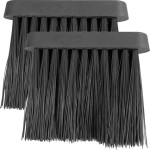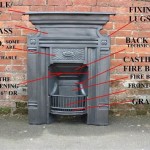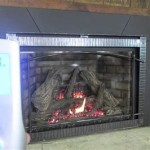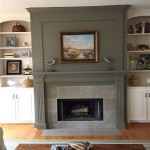Antique Wood Fireplace Fenders: History, Design, and Value
Antique wood fireplace fenders, often overlooked components of historic hearths, offer a glimpse into the past. These protective barriers, designed to prevent embers and hot coals from escaping the fireplace, evolved from purely functional objects to decorative elements, reflecting the aesthetic styles and social customs of their respective eras. Examining the history, design features, and factors influencing the value of antique wood fireplace fenders provides a comprehensive understanding of their significance.
Fireplace fenders emerged as a practical necessity in homes with open hearths. Before the widespread adoption of enclosed stoves and central heating systems, fireplaces served as the primary source of heat and cooking. The open fire, while providing warmth and sustenance, also presented a significant fire hazard. Stray embers and coals could easily ignite flammable materials such as rugs, furniture, and even clothing, leading to potentially disastrous consequences. Early fenders, therefore, were primarily designed for safety, constructed from simple materials like iron or plain wood.
As fireplace technology advanced and homes became more refined, so did the design and craftsmanship of fireplace fenders. The introduction of coal as a fuel source, which produced hotter and more persistent embers, further reinforced the need for robust and effective barriers. Wood fenders, while aesthetically pleasing, needed to be properly constructed to withstand the heat and occasional impacts. The evolution of fender design also mirrored the changing architectural styles and decorative trends, with fenders becoming increasingly ornate and integrated into the overall aesthetic of the fireplace surround.
The Historical Development of Wood Fireplace Fenders
The history of fireplace fenders is intrinsically linked to the evolution of heating technology and interior design. Early examples were often rudimentary, reflecting the limited resources and practical concerns of the time. These simple fenders primarily served a functional purpose, preventing the spread of fire without much emphasis on aesthetics. Materials were typically readily available and inexpensive, such as unfinished wood or basic ironwork. The focus was on creating a durable barrier that would contain the embers and protect the surrounding area.
During the 18th and 19th centuries, the design and construction of fireplace fenders became more sophisticated. The rise of the middle class and the increasing emphasis on domestic comfort led to a greater demand for decorative items. Fireplace fenders were no longer solely functional but also served as a statement of wealth and taste. Craftsmen began to incorporate finer materials and intricate designs, reflecting the prevailing architectural styles, such as Georgian, Regency, and Victorian. Wood fenders, often crafted from hardwoods like mahogany or oak, were adorned with carvings, inlays, and other decorative embellishments.
The Victorian era, in particular, witnessed a proliferation of elaborate fireplace fenders. The Victorian aesthetic, characterized by its eclecticism and love of ornamentation, extended to fireplace design. Fenders became larger and more ornate, often featuring intricate fretwork, brass accents, and even small decorative feet. The use of rich, dark woods added to the overall sense of opulence and grandeur. These elaborate fenders served as a focal point within the room, contributing to the overall ambiance of warmth and comfort.
The 20th century saw a shift towards simpler and more streamlined designs. The rise of modernism and the increasing popularity of central heating systems led to a decline in the use of open fireplaces and, consequently, a decreased demand for elaborate fenders. While some antique fenders continued to be valued for their historical significance, new designs tended to be more functional and less ornate. The focus shifted towards efficiency and practicality, with simpler materials and cleaner lines becoming the norm.
Design Features and Materials of Antique Wood Fireplace Fenders
Antique wood fireplace fenders exhibit a wide range of design features, reflecting the diverse aesthetic preferences of different periods. The basic design typically consists of a horizontal panel, often raised slightly above the floor, that spans the width of the fireplace opening. This panel is supported by legs or feet, which provide stability and prevent the fender from tipping over. The height of the fender is typically low enough to allow for easy access to the fire while still providing adequate protection against escaping embers.
The materials used in the construction of antique wood fireplace fenders vary depending on the period, the intended purpose, and the available resources. Hardwoods such as mahogany, oak, and walnut were commonly used for their durability and aesthetic appeal. These woods could be easily carved and polished, allowing for intricate designs and decorative embellishments. Softer woods, such as pine, were sometimes used for simpler or less expensive fenders. The wood was often treated with a protective finish, such as varnish or lacquer, to enhance its durability and protect it from the heat of the fire.
In addition to wood, antique fireplace fenders often incorporate other materials, such as metal and leather. Brass was a popular choice for decorative accents, such as trim, studs, and finials. Brass added a touch of elegance and sophistication to the fender, complementing the natural beauty of the wood. Leather was sometimes used to cover the front panel of the fender, providing a soft and comfortable surface to lean against. Leather also offered a degree of protection against heat and sparks.
Design variations among antique wood fireplace fenders are numerous. Some fenders feature a solid panel, while others have an open fretwork design. Fretwork allows for greater air circulation and reduces the risk of the fender overheating. Carved details, such as floral motifs, geometric patterns, and coats of arms, were common on more elaborate fenders. The design of the legs or feet also varied, with some fenders featuring simple straight legs and others having more ornate curved or clawed feet. The overall design of the fender was often influenced by the architectural style of the house and the preferences of the homeowner.
Factors Influencing the Value of Antique Wood Fireplace Fenders
The value of an antique wood fireplace fender is determined by a variety of factors, including its age, condition, rarity, craftsmanship, and provenance. Older fenders, particularly those from the 18th and 19th centuries, tend to be more valuable than later examples. Fenders in excellent condition, with minimal damage or wear, command higher prices than those that have been heavily used or poorly maintained. Rarity also plays a significant role in determining value, with unique or unusual designs being highly sought after by collectors.
The quality of craftsmanship is another key factor influencing value. Fenders that were skillfully crafted by experienced artisans are typically more valuable than those that were mass-produced or poorly made. The presence of intricate carvings, fine inlays, and other decorative embellishments can significantly increase the value of a fender. The type of wood used in the construction of the fender also affects its value, with hardwoods like mahogany and walnut being more desirable than softer woods like pine.
Provenance, or the history of ownership, can also impact the value of an antique wood fireplace fender. Fenders that can be traced back to a notable historical figure or a significant event are often highly prized by collectors. Documentation, such as receipts, letters, or photographs, that verifies the fender's provenance can significantly enhance its value. Even without such documentation, a compelling story or association can add to the overall appeal and perceived value of the fender.
The current market demand for antique fireplace fenders also plays a role in determining their value. Trends in interior design and collecting can influence the popularity of certain styles or periods of fenders. Fenders that are currently in high demand are likely to command higher prices than those that are less fashionable. Auction results, dealer catalogs, and online marketplaces can provide valuable insights into current market trends and pricing.
In summary, the value of an antique wood fireplace fender is a complex equation that takes into account a variety of factors. Age, condition, rarity, craftsmanship, provenance, and market demand all contribute to the overall value of these historical artifacts. Careful evaluation of these factors is essential for both buyers and sellers to ensure a fair and accurate assessment of value.

Antique French Fireplace Fender

Antique Fender Oak 131

Antique French Fireplace Fender

1800 S Antique Turned Wood Fireplace Fender Chairish

Ic5212 Antique Fireplace Fender Legacy Vintage Building Materials Antiques

Old Golden Oak 2 Piece Fireplace Surround Hearth Fender W Carved Lion Paw Detail

Antique French Fireplace Fender

Antique Art Nouveau Fireplace Stove Fender Plant Holder Ruby Lane

1800 S Antique Turned Wood Fireplace Fender Chairish

Large Antique Fire Kerb English Victorian Oak Fireside Fender Circa 1870 At 1stdibs Wooden Hearth Fireplace
Related Posts








